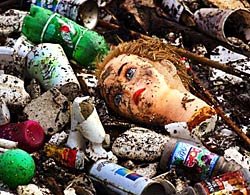The Problem with Plastics!

Plastic is durable and long-lasting, qualities which made it seem like the perfect substance for a diversity of uses. But these factors, combined with others that are increasingly being researched, turn out to be some of the major problems of plastic.
Sustainability has become a key phrase in recent environmental discussions. Sustainable resources are ones that can continue to be used and will still be available for future generations. They can include energy resources like wind and sunlight or biological resources like plants. Plastic is made from oil and coal, materials which are both unsustainable and non-renewable. These resources also result in environmental damage when being mined, transported, and used in production processes; plastic production contributes to problems such as oil spills, toxic emissions, and global warming through the release of greenhouse gases.
After a plastic container is used, it may be thrown away or recycled. Yet even if the latter step was taken for every piece of plastic, and no greater quantity of plastic was needed, non-renewable resources would still have to be used to produce more. This is because when plastic is being reprocessed, it changes to a lower grade or quality. For example, plastic PET bottles such as the ones Coke uses for cold drinks cannot be recycled into new Coke bottles. The little bit of recycled plastic that may become a new bottle must be supplemented with new plastic. Also, it is feared that contaminants surviving the recycling process would be able to leach into food from the containers. Thus, while plastic is “recyclable”, it is not “sustainably recyclable”.
Plastics can take up to 10,000 years to biodegrade, making landfilling an poor solution for the massive quantities produced. There are also many problems with the practice of incineration, especially when plastics are burned. Dioxins and furans are two highly toxic chemicals created unintentionally in this process. Technology exists that separates some of these particles during the burning, but this only consolidates the chemicals in the ash, not solving the problem of their presence.
Plastic comes in hundreds of different varieties. In South Africa, there are around 60 chemically different kinds of plastic, each with around 20 to 30 different grades. This adds to the difficulty of collection, sorting, and recycling. It also adds uncertainty regarding the properties and impacts of the plastics.
Courtesy of the Zero Institute for Waste in Africa

